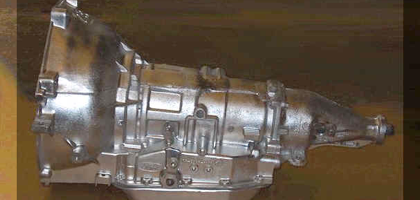26 Making Your AOD Perform
Making your AOD Perform
Tuesday, November 26, 1996

Making your AOD perform is a topic that instantly prompts many people to ask, “Why bother?” The answer, when set up properly they can give the best of everything and be very reliable.
The only truly weak link that needs to be addressed is overdrive. Overdrive is not as much of a problem in the wide ratio AOD which was first introduced in ’94 trucks and all rear drive modular motors including the Mustang. This trans is called the 4R7W and has an improved overdrive band system and a wide ratio gear set that is available in a kit from SVO, but our main focus is the standard AOD with the more popular 2.46 first gear that came in the ’93 and older Mustangs that are non electronically controlled.
To make an AOD survive in an extreme duty situation the lock-up feature has to go. If you’re serious about making your AOD perform reliably, eliminating lock-up is not open to debate. On non electronic AOD’s the lock-up is achieved the instant the trans shifts into third and stays locked into 4th and does not unlock until it downshifts into 2nd or 1st. With higher horsepower levels the 3d gear shift (and subsequent lock-up) places serious stress on the direct clutch and the smallest of the two input shafts and can be catastrophic. Locking the converter when shifting into 3rd will often twist or snap the smaller of the two input shafts, the splined hub in the converter were the shaft engages to achieve the lock-up can also strip out and the direct drum’s clutches which are applied for third can be hurt.
As we mentioned earlier, overdrive is also a constant problem in high horsepower applications and fails regularly, largely because the overdrive band is inherently weak. Even with our Super-Duty AOD we recommend that when shifting into overdrive it is done under as little load as possible or when already up to cruising speed. This simple practice significantly increases the life of the OD band under any conditions, even with a stock type locking converter.
Another practice that is detrimental to the OD band is the shifting from 1 to D then immediately back to 1 to hold the trans in 2nd gear. Shifting 2nd gear manually this way engages the OD band while the shifter is being pulled back into 1. The trans does this to achieve a braking affect upon declaration while in 2nd. The OD band engages before the 2nd gear clutch during that 1 to D then back to 1 manual shifting and the OD band is too weak for that type of load, so it wears prematurely and loses its clamping power. To avoid this problem when manually shifting from 1st to 2nd, move the shifter to D to engage 2nd and then wait a second for the shift to be completed, then pull it back into 1 to hold it until it’s time to shift into 3rd. This way, the OD band engages after the shift has already occurred and posses no load at that point. When you’re ready for 3rd, simply move the stick into D.
Another solution to avoid wearing the OD band prematurely when shifting from 1st to 2nd, is to let the trans make the 1-2 shift automatically. Unfortunately, an AOD left in Drive will usually make it’s shifts around at 5000 rpm. Most modified 5.0s need to be shifted at 5500 rpm or more. This can be remedied by reprogramming the shifts with a high quality shift kit, but rarely will the first attempt yield the desired shift points.
We’ve addressed the major problems with AOD longevity, but there are other measures necessary to ensure reliable operation under high horsepower. Our Super-Duty AOD’s are set up with four clutches in second, which are the maximum that can be realistically fitted. We also use 8 in the 3d clutch drum. Several oil passages are modified for better lubrication, and we use only Carl Baumann shift kits which have been very reliable for over five years now.
With torque converters, you get what you pay for and we use only non-lock-up Stallion Converters which are by far the highest quality available. If the car will see only limited slick usage and drag strip time, it isn’t necessary to change the input shafts. If the trans will be used behind a street/strip car that runs in the low 11s we install a higher quality little (3rd and 4th) input shaft, the primary shaft is fine at these power levels. For more serious efforts (high 10’s or better) it’s necessary to use the Art Carr one piece input shaft with a matched converter.
All the theory in the world is fine, but how does a modified AOD perform and hold up in the real world? We’ve built several AODs for cars that run mid to high tens, and with the one piece input shaft they’ve been trouble free. Our ’88 LX has gone low tens all of the ’96 season with no failure thus far and will continue to be used in ’97 when the car is sure to run high 9s. When built correctly, an AOD like our Super-Duty AOD will be very reliable and perform on par with T-5’s. The transmission can even be left in drive for completely automatic shifting. The hands-free shifting and rpm saving overdrive coupled with the new found reliability and strength, makes an AOD a high-performance, docile transmission that anyone can drive, just ask my wife.
